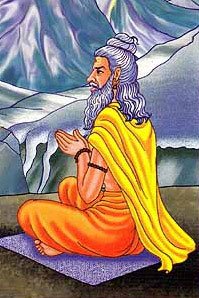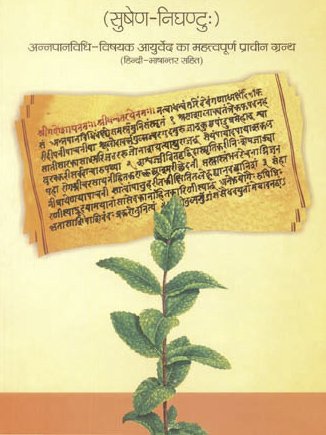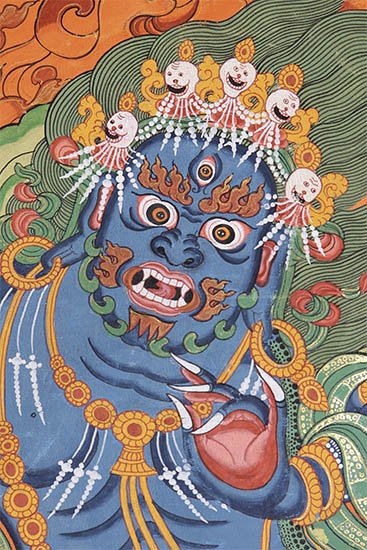Susvara, Su-svara, Susvarā: 15 definitions
Introduction:
Susvara means something in Buddhism, Pali, Hinduism, Sanskrit, Jainism, Prakrit, Marathi, Hindi. If you want to know the exact meaning, history, etymology or English translation of this term then check out the descriptions on this page. Add your comment or reference to a book if you want to contribute to this summary article.
In Hinduism
Purana and Itihasa (epic history)
Source: archive.org: Puranic EncyclopediaSusvarā (सुस्वरा).—A Gandharva woman. (See under Pramohinī).

The Purana (पुराण, purāṇas) refers to Sanskrit literature preserving ancient India’s vast cultural history, including historical legends, religious ceremonies, various arts and sciences. The eighteen mahapuranas total over 400,000 shlokas (metrical couplets) and date to at least several centuries BCE.
Ayurveda (science of life)
Veterinary Medicine (The study and treatment of Animals)
Source: Shodhganga: Portrayal of Animal Kingdom (Tiryaks) in Epics An Analytical studySusvara (सुस्वर) (lit. “one who has a melodious voice”) is a synonym (another name) for Garuḍa, according to scientific texts such as the Mṛgapakṣiśāstra (Mriga-pakshi-shastra) or “the ancient Indian science of animals and birds” by Hamsadeva, containing the varieties and descriptions of the animals and birds seen in the Sanskrit Epics such as the Ramayana and Mahabharata.

Āyurveda (आयुर्वेद, ayurveda) is a branch of Indian science dealing with medicine, herbalism, taxology, anatomy, surgery, alchemy and related topics. Traditional practice of Āyurveda in ancient India dates back to at least the first millenium BC. Literature is commonly written in Sanskrit using various poetic metres.
In Buddhism
Tibetan Buddhism (Vajrayana or tantric Buddhism)
Source: Wisdom Library: Tibetan Buddhism1) Susvara (सुस्वर) is the name of a Tathāgata (Buddha) mentioned as attending the teachings in the 6th century Mañjuśrīmūlakalpa: one of the largest Kriyā Tantras devoted to Mañjuśrī (the Bodhisattva of wisdom) representing an encyclopedia of knowledge primarily concerned with ritualistic elements in Buddhism. The teachings in this text originate from Mañjuśrī and were taught to and by Buddha Śākyamuni in the presence of a large audience (including Susvara).
2) Susvara (सुस्वर) is also the name of a Kinnara mentioned as attending the teachings in the 6th century Mañjuśrīmūlakalpa.
3) Susvarā (सुस्वरा) is also the name of a Yakṣiṇī mentioned as attending the teachings in the 6th century Mañjuśrīmūlakalpa.

Tibetan Buddhism includes schools such as Nyingma, Kadampa, Kagyu and Gelug. Their primary canon of literature is divided in two broad categories: The Kangyur, which consists of Buddha’s words, and the Tengyur, which includes commentaries from various sources. Esotericism and tantra techniques (vajrayāna) are collected indepently.
In Jainism
General definition (in Jainism)
Source: archive.org: TrisastisalakapurusacaritraSusvarā (सुस्वरा) is the name of a bell, according to chapter 2.2 [ajitanātha-caritra] of Hemacandra’s 11th century Triṣaṣṭiśalākāpuruṣacaritra: an ancient Sanskrit epic poem narrating the history and legends of sixty-three illustrious persons in Jainism.
Accordingly: “[...] then the bells, [i.e., Susvarā], belonging respectively to the Nagas, etc., of the two divisions of the Bhavanapatis, rang, struck three times by generals named Bhadrasena belonging to Dharaṇa, etc., and by those named Dakṣa belonging to Bhūtānanda, etc. Then all the Nāgas, etc., of the two rows came instantly each to his own Indra, like horses to their own stables. At their command their respective Ābhiyogika-gods created at once cars variegated with jewels and gold, twenty-five thousand yojanas square, with indradhvajas of two hundred and fifty yojanas. [...]”.
Source: Encyclopedia of Jainism: Tattvartha Sutra 8: Bondage of karmasSusvara (सुस्वर) refers to a “melodious voice” and represents one of the various kinds of Nāma, or “physique-making (karmas)”, which represents one of the eight types of Prakṛti-bandha (species bondage): one of the four kinds of bondage (bandha) according to the 2nd-century Tattvārthasūtra chapter 8. What is meant by the melodious voice (susvara) body-making karma? The rise of which causes a living being to have sweet and likable voice by others is called melodious voice body-making karmas.
The opposite-pair of susvara (melodious voice) is duḥsvara (harsh voice).

Jainism is an Indian religion of Dharma whose doctrine revolves around harmlessness (ahimsa) towards every living being. The two major branches (Digambara and Svetambara) of Jainism stimulate self-control (or, shramana, ‘self-reliance’) and spiritual development through a path of peace for the soul to progess to the ultimate goal.
Languages of India and abroad
Marathi-English dictionary
Source: DDSA: The Molesworth Marathi and English Dictionarysusvara (सुस्वर).—n (S) A musical or pleasant note, tone, or sound.
--- OR ---
susvara (सुस्वर).—a (S) Of a good tone or musical sound.
--- OR ---
susvara (सुस्वर).—f (Commonly susara) An alligator. Pr. taḷyācyā āśēnēṃ susvara mēlī.
Source: DDSA: The Aryabhusan school dictionary, Marathi-Englishsusvara (सुस्वर).—m A musical note. f An alliga- tor. a Of a good tone.
Marathi is an Indo-European language having over 70 million native speakers people in (predominantly) Maharashtra India. Marathi, like many other Indo-Aryan languages, evolved from early forms of Prakrit, which itself is a subset of Sanskrit, one of the most ancient languages of the world.
Sanskrit dictionary
Source: DDSA: The practical Sanskrit-English dictionarySusvara (सुस्वर).—a.
1) melodious, harmonious.
2) loud. °यन्त्रकम् (yantrakam) a kind of musical instrument; युता सुस्वरयन्त्रकैः (yutā susvarayantrakaiḥ) Śukra.1.247.
Susvara is a Sanskrit compound consisting of the terms su and svara (स्वर).
Source: Cologne Digital Sanskrit Dictionaries: Benfey Sanskrit-English DictionarySusvara (सुस्वर).—adj. loud,
Susvara is a Sanskrit compound consisting of the terms su and svara (स्वर).
Source: Cologne Digital Sanskrit Dictionaries: Cappeller Sanskrit-English DictionarySusvara (सुस्वर).—[adjective] sounding well or loud; [neuter] [adverb]
Source: Cologne Digital Sanskrit Dictionaries: Monier-Williams Sanskrit-English Dictionary1) Susvara (सुस्वर):—[=su-svara] [from su > su-saṃyata] m. the right tone or accent, [Śikṣā]
2) [v.s. ...] mf(ā)n. having a beautiful voice, [Mahābhārata]
3) [v.s. ...] mf(ā)n. well-sounding, harmonious, melodious (am ind.), [Kāvya literature; Kathāsaritsāgara]
4) [v.s. ...] mf(ā)n. loud (am ind.), [Mahābhārata; Rāmāyaṇa] etc.
5) [v.s. ...] m. a conch, [cf. Lexicographers, esp. such as amarasiṃha, halāyudha, hemacandra, etc.]
6) [v.s. ...] Name of a son of Garuḍa, [Mahābhārata]
Source: DDSA: Paia-sadda-mahannavo; a comprehensive Prakrit Hindi dictionary (S)Susvara (सुस्वर) in the Sanskrit language is related to the Prakrit words: Susara, Sussara, Sussarā, Sūsara.
[Sanskrit to German]
Sanskrit, also spelled संस्कृतम् (saṃskṛtam), is an ancient language of India commonly seen as the grandmother of the Indo-European language family (even English!). Closely allied with Prakrit and Pali, Sanskrit is more exhaustive in both grammar and terms and has the most extensive collection of literature in the world, greatly surpassing its sister-languages Greek and Latin.
Hindi dictionary
Source: DDSA: A practical Hindi-English dictionarySusvara (सुस्वर):—(a and nm) melodious voice/tune; hence ~[tā] (nf).
...
Kannada-English dictionary
Source: Alar: Kannada-English corpusSusvara (ಸುಸ್ವರ):—[noun] a melodious, pleasing note or sound.
Kannada is a Dravidian language (as opposed to the Indo-European language family) mainly spoken in the southwestern region of India.
See also (Relevant definitions)
Partial matches: Svara, Cu, Shu.
Starts with: Susvaram, Susvarata.
Full-text: Sussara, Susvaram, Sausvarya, Jaladharagarjitaghoshasusvaranakshatrarajasamkusumitabhijna, Susara, Pramohini, Nadabrahma, Garajanem, Agnipa, Duhsvara, Nama, Tanta.
Relevant text
Search found 11 books and stories containing Susvara, Su-svara, Susvarā; (plurals include: Susvaras, svaras, Susvarās). You can also click to the full overview containing English textual excerpts. Below are direct links for the most relevant articles:
Puranic encyclopaedia (by Vettam Mani)
Chaitanya Bhagavata (by Bhumipati Dāsa)
Verse 2.7.73 < [Chapter 7 - The Meeting of Gadādhara and Puṇḍarīka]
Brihad Bhagavatamrita (commentary) (by Śrī Śrīmad Bhaktivedānta Nārāyana Gosvāmī Mahārāja)
Verse 1.3.4 < [Chapter 3 - Prapañcātīta (beyond the Material Plane)]
Verse 1.6.123 < [Chapter 6 - Priyatama (the most beloved devotees)]
Trishashti Shalaka Purusha Caritra (by Helen M. Johnson)
Tattva 3: Puṇya (merit) < [Appendix 1.4: The nine tattvas]
Appendix 1.2: types of karma < [Appendices]
Part 8: Birth-ceremonies presided over by Śakra < [Chapter II - Birth of Ajita and Sagara]
Bhagavati-sutra (Viyaha-pannatti) (by K. C. Lalwani)
Mahabharata (English) (by Kisari Mohan Ganguli)
Section CI < [Bhagavat-Yana Parva]